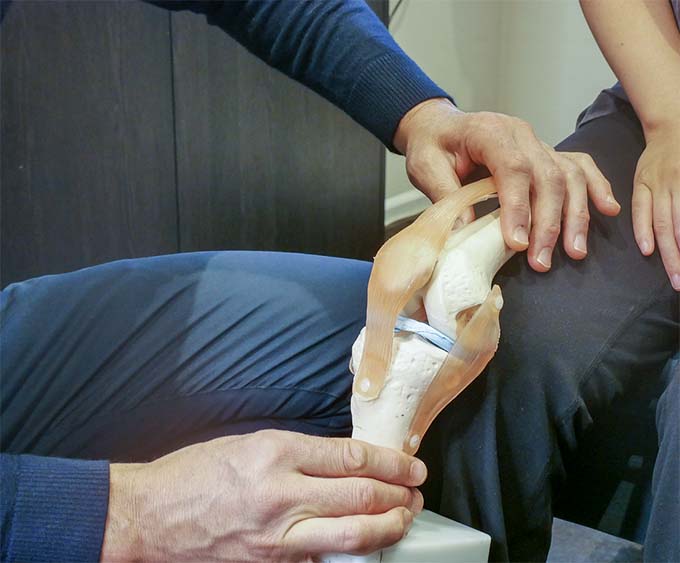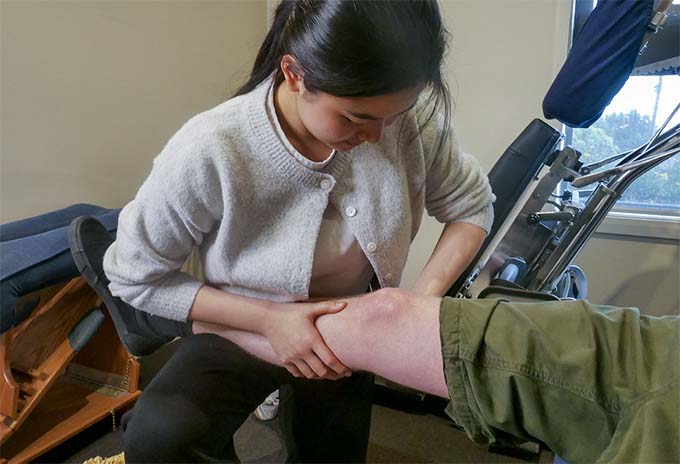Premier Melbourne Chiropractors
✓ Onsite Parking ✓ Wheelchair Access ✓ X-Ray - 424 Blackburn Rd, Glen Waverley VIC 3150
✓ Onsite Parking ✓ Wheelchair Access ✓ X-Ray
424 Blackburn Rd, Glen Waverley
Knee Pain Conditions
Trained In Diagnosing, Treating And Managing Knee Pain Issues.
Understanding Knee Pain Conditions
Knee pain is a widespread issue that affects people of all ages, from athletes to the elderly. It's one of the most common complaints we see and can arise from a variety of causes, both acute and chronic. Everyday activities such as walking, standing, or even sitting can become challenging when someone experiences knee pain. The prevalence of knee pain has increased over the years, partly due to longer life expectancies and more active lifestyles, which can lead to wear and tear on the joint. The knee is a complex structure made up of bones, cartilage, ligaments, and tendons, all of which are vital for its function. Injury or strain to any of these components can result in significant pain and discomfort. Factors such as age, physical activity level, weight, and previous knee injuries can all contribute to the development of knee pain. For instance, high-impact sports or repetitive movements can increase the risk, while obesity places additional stress on the joints, potentially leading to pain over time.
This page contains info on common knee pain conditions that our Doctors handle.
Knee Osteoarthritis
Knee osteoarthritis is a degenerative joint disease that primarily affects the cartilage within the knee. It occurs when the cartilage, which acts as a cushion between the bones in the knee joint, gradually wears away. As this cushioning diminishes, the bones may begin to rub against each other, leading to pain, swelling, and stiffness. This condition can be more prevalent in older adults due to the natural wear and tear on the joints over time, but younger individuals can also be affected, especially if they have a history of knee injury or other contributing factors. The symptoms of knee osteoarthritis often progress slowly, making them subtle at the onset. Individuals may initially notice a mild ache or stiffness in the knee joint, particularly after periods of inactivity or excessive use. Over time, these symptoms can become more pronounced, with increased pain during physical activities like walking, climbing stairs, or even standing for extended periods. Some people also experience decreased mobility and flexibility in the knee, which can impact their daily life and activities. The variability in symptoms means that each person’s experience with knee osteoarthritis can be quite different.

Age is a significant factor, as the likelihood of developing osteoarthritis increases with advancing years. Factors such as obesity can exert extra pressure on knee joints, accelerating cartilage breakdown. Genetics also play a role where people with a family history of osteoarthritis are more likely to develop the condition themselves. Occupations or activities that involve repetitive stress on the knee, such as kneeling, squatting, or heavy lifting, can elevate the risk of joint wear and tear.
Diagnosis And Treatment For Knee Osteoarthritis
Our chiropractors are qualified to diagnose and manage knee osteoarthritis. During an initial assessment, we will take a detailed patient history and perform a thorough physical examination of the knee joint. This might include evaluating the range of motion, checking for swelling or tenderness, and assessing the gait. In some cases, imaging studies such as X-rays or MRI scans may be required to visualise the extent of cartilage loss and rule out other possible causes of knee pain. Once a diagnosis of knee osteoarthritis is confirmed, we employ a multifaceted treatment approach. By tailoring a treatment plan to each individual's needs, our goal is to help manage symptoms and improve the quality of life for those with knee osteoarthritis.
Patellofemoral Pain Syndrome (Runner's Knee)
Patellofemoral Pain Syndrome (PFPS), commonly known as Runner's Knee, is a condition where a person feels pain around the front of the knee. It frequently affects athletes and people who engage in repetitive knee activities such as running, jumping, and squatting. The pain is typically felt in the area where the kneecap (patella) meets the lower end of the thigh bone (femur). Due to its nature, PFPS can interfere with daily activities, such as climbing stairs or sitting for prolonged periods, often causing discomfort and limitations in movement.
The causes of Patellofemoral Pain Syndrome are varied and may include abnormalities in knee alignment, muscle imbalances around the knee and hip, or overuse resulting from increased activity levels. Factors such as weak muscles, particularly in the quadriceps or hip abductors, can contribute to inadequate support for the knee joint. Biomechanical issues such as flat feet or improper running techniques might exacerbate the condition, leading to increased stress on the knee joint and surrounding structures.
PFPS can affect individuals beyond athletes, influencing anyone who participates in activities that place stress on the knee joint. Sudden increases in physical activity without appropriate conditioning can also contribute to the development of symptoms. Gender differences have been noted as well, with women being more susceptible possibly due to wider pelvis shapes that can alter leg alignment.
Diagnosis And Treatment Of Runner’s Knee
When diagnosing Patellofemoral Pain Syndrome, we begin with a comprehensive assessment that includes a review of the patient’s medical history, a physical examination, and an evaluation of the movement patterns that may be contributing to the syndrome. This allows us to identify any muscle imbalances, misalignments, or biomechanical issues that might be present. Advanced imaging techniques, while not always required, can be helpful in ruling out other conditions or confirming the diagnosis.
Treatment plans are personalised to address the specific needs of the patient and often include a combination of manual therapies, exercise prescriptions, and lifestyle modifications. Manual therapies such as joint mobilisations or soft tissue techniques aim to improve joint function and reduce pain. Proper diagnosis and treatment from a Gonstead chiropractor has shown to help many patients manage symptoms, improve knee function, and prevent future occurrences of PFPS.
Patellar Tendonitis (Jumper’s Knee)

Patellar Tendonitis, also referred to as Jumper’s Knee, is an overuse injury that primarily affects athletes engaged in jumping sports, such as basketball and volleyball. It arises from repeated stress on the patellar tendon, which connects the kneecap to the shin bone. This repetitive strain causes microscopic tears in the tendon, leading to pain and inflammation. Individuals may notice discomfort just below the kneecap, especially when jumping, running, or bending the knee. This condition is not exclusive to professional athletes; it can also affect recreational sports enthusiasts and young athletes going through growth spurts. The rigorous training schedules, common in competitive sports, often contribute to the development of Jumper’s Knee as they increase the frequency and intensity of physical activity. Hard playing surfaces and insufficient warm up practices are additional factors that can exacerbate the stress placed on the patellar tendon, increasing the likelihood of this condition occurring.
Managing athletic training loads reduces the risk of Patellar Tendonitis. Balancing periods of activity with adequate rest gives the tendon time to recover and adapt to the stressors placed upon it. Athletes should pay attention to any early signs of discomfort, taking proactive measures to avoid further stressing the tendon.
Diagnosis and Treatment Of Jumper’s Knee
When it comes to diagnosing Patellar Tendonitis, and with our chiropractors being muscloskeletal specialists, they are well equipped to assess and manage your patellar tendon. Through a thorough examination, we can identify any areas of tenderness or inflammation around the knee joint, as well as evaluate your range of motion and muscle strength. In addition to a physical examination, imaging tests such as an X-ray or MRI may be ordered to confirm the diagnosis and initiate a treatment plan.
Knee Ligament Injuries (ACL, MCL, PCL, LCL)
Knee ligament injuries are among the most common issues affecting athletes and active individuals. The knee joint is stabilised by four key ligaments: the Anterior Cruciate Ligament (ACL), the Medial Collateral Ligament (MCL), the Posterior Cruciate Ligament (PCL), and the Lateral Collateral Ligament (LCL). Each of these ligaments help in maintaining the knee's stability and function.
-
The ACL helps control rotational movements and preventing the tibia from sliding too far forward.
-
The MCL is located on the inner side of the knee and helps resist forces pushing the knee inward.
-
The PCL, found at the back of the knee, prevents the tibia from moving too far backward.
-
Finally, the LCL is on the outer side of the knee and works against forces pushing the knee outward.
Injury to any of these ligaments can result in significant instability and discomfort, often arising from sudden changes in direction, impacts, or overstretched movements during physical activities. Knee ligament injuries can be classified as either sprains or tears. A sprain refers to the stretching or tearing of a ligament, while a tear indicates a complete rupture of the ligament. Depending on the severity of the injury, people may experience mild to severe pain, swelling, difficulty moving the knee joint, and instability. In some cases, patients may also hear a popping sound at the time of injury.
Risk factors for knee ligament injuries include engaging in high impact sports such as footy, soccer, basketball, or skiing, which demand quick changes in direction and extensive physical exertion. Additionally, inadequate conditioning, poor technique, and an imbalanced training routine can predispose individuals to these injuries. Anatomical factors such as limb alignment, joint laxity, and muscular strength also play roles in susceptibility. Wearing appropriate footwear and using proper sporting equipment are crucial steps in reducing the likelihood of knee ligament injuries.
Diagnosis And Treatment Of A Knee Ligament Injury
Our precise diagnosis of any knee ligament injury begins with a comprehensive evaluation process that combines thorough physical examination with advanced diagnostic imaging. During a physical examination, a Doctor will assess the knee's range of motion, stability, and look for signs of tenderness or swelling. Special tests like the Lachman test or the pivot-shift test may be performed to identify specific ligamentous laxity. To complement these physical assessments, advanced imaging modalities such as MRI or ultrasound might be utilised to provide a detailed view of the ligaments, helping to differentiate between sprains and tears. This precise diagnostic approach allows for a targeted treatment plan, tailored to the individual's specific injury and recovery needs, enabling optimal healing and rehabilitation.
IT Band Syndrome
Another knee issue that not many people have heard of, but is prevalent, is Iliotibial Band Syndrome (ITBS). This is a common overuse injury that primarily affects athletes, especially runners and cyclists. Located on the outer side of the thigh, the iliotibial band is a thick band of fibrous tissue that runs from the hip to the knee. Its primary function is to provide stability to the knee joint during movement. Repetitive flexion and extension of the knee, such as those experienced during extended periods of running, can lead to irritation and inflammation of this band, resulting in IT Band Syndrome.
The onset of IT Band Syndrome is typically marked by a sharp or burning pain on the outside of the knee. This discomfort often arises during physical activity and may worsen with continued exertion. Over time, the pain can become pronounced enough to limit an athlete's ability to continue their workout. Factors contributing to the development of IT Band Syndrome include poor training habits, inadequate footwear, running on uneven surfaces, and anatomical conditions such as leg length discrepancies or weak hip muscles.
Preventing IT Band Syndrome involves focusing on building strength and flexibility in the lower body, particularly targeting the hip abductors and glutes. Proper warm up exercises, incorporating stretching routines, and gradually increasing the intensity of physical activity can help reduce the risk. Additionally, paying attention to proper form and alignment during workouts, as well as ensuring appropriate gear and footwear, are critical aspects of prevention. By being mindful of these practices, athletes can maintain optimal performance while mitigating the risk of developing IT Band Syndrome.
Diagnosis And Treatment Of ITBS
When seeking a diagnosis for Iliotibial Band Syndrome, we firstly determine what area and movements are causing the pain. Through targeted physical exams and assessments, we can identify which muscles, tendons, and ligaments are affected. This information is crucial in determining the treatment plan, which usually involves a combination of manual therapy techniques, exercises, and lifestyle changes.
One key aspect of chiropractic treatment for IT Band Syndrome is addressing any underlying joint misalignments. These misalignments can cause tension and irritation in the muscles surrounding the iliotibial band, leading to inflammation and pain. By using specific adjustments to correct these imbalances, we can give knee pain relief and alleviate associated symptoms and improve overall function.
Other Knee Pain Conditions
In terms of other types of knee issues outside of the main ones, there are a few that are worth mentioning.
Here we have listed them out with a brief rundown of each one:
Meniscus Tears: The meniscus is a tough, rubbery cartilage that sits between the thigh bone and shin bone. It acts as a shock absorber for the knee joint. Tears in the meniscus can occur from sudden twisting or pivoting movements, often seen in sports such as basketball or football. Symptoms include pain, swelling, and stiffness in the knee, along with difficulty straightening it fully.
Knee Bursitis: Bursae are small, fluid-filled sacs that act as cushions between bones and soft tissues. Knee bursitis is the inflammation of one or more of these bursae, usually due to overuse or repetitive pressure on the knee joint. Symptoms include pain, swelling, and tenderness around the affected area. Similar to Elbow Bursitis which you can read all about here.
Knee Subluxation: This is a condition where the kneecap (patella) partially dislocates from its normal position. It most commonly occurs during physical activity and can cause pain, instability, and difficulty bending or straightening the knee.
Baker’s Cyst: Also known as a popliteal cyst, this is a fluid-filled swelling at the back of the knee joint. It can develop as a result of underlying knee conditions such as osteoarthritis or rheumatoid arthritis. Symptoms include pain, stiffness, and difficulty bending the knee fully. Treatment for Baker's cysts may involve draining the fluid or addressing the underlying condition causing it.
Gout: Although not exclusive to the knees, gout is a form of arthritis that commonly affects joints in the lower body, including the knees. This condition is caused by a buildup of uric acid crystals in the joint, leading to sudden and severe pain, redness, and inflammation. To prevent gout attacks, it is important to maintain a healthy diet and lifestyle, avoid trigger foods high in purines (such as red meat and alcohol), and stay hydrated.
Osgood-Schlatter Disease: This condition primarily affects adolescents who are going through growth spurts. It causes pain and swelling just below the knee, where the patellar tendon attaches to the shinbone. Osgood-Schlatter disease can be caused by overuse or repetitive strain on the knee from sports or physical activities that involve jumping or running. Treatment includes rest, ice, and stretching exercises.
Popliteal Entrapment Syndrome: This rare condition occurs when muscles or tendons in the thigh compress the popliteal artery, the main blood supply to the lower leg. This can result in pain, numbness, and weakness in the affected leg, particularly during physical activity. Popliteal entrapment syndrome often requires surgery to release the pressure on the artery.
Referred Knee Pain: Sometimes, pain in the knee can be a symptom of an issue in another part of the body, such as the hips or lower back. This is known as referred pain and addressing the underlying issue can alleviate knee pain.
Knee Pain Treatment
Don't let knee pain limit your daily activities or overall quality of life. Our chiropractic team is dedicated to providing personalised care tailored to your specific needs. Whether you're dealing with a sports injury, arthritis, or general wear and tear, we are here to support you on your journey to recovery. Take the first step towards a pain free life by scheduling a consultation with us. Call our office or book an appointment online today and let us help you regain the freedom to move comfortably again.

Have a question about knee pain Chiropractic care?
